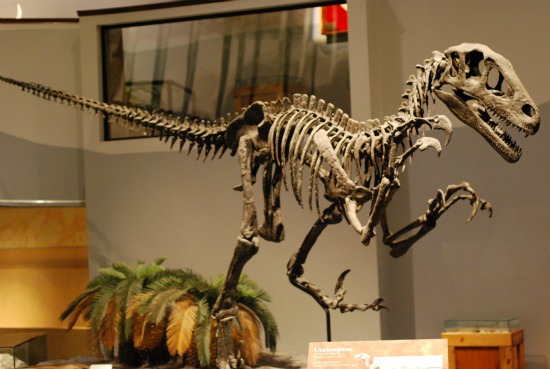What Do We Really Know About Utahraptor?
/https://tf-cmsv2-smithsonianmag-media.s3.amazonaws.com/filer/20110520083307utahraptor-skeleton.jpg)
When it was released in 1993, Jurassic Park turned Velociraptor into a household name. Agile and cunning, it was a type of predatory dinosaur theater audiences hadn't seen before. But paleontologists knew the movie's raptors were drawn with a bit of artistic license. For one thing, the dinosaurs had actually been based on the sickle-clawed predator Deinonychus, and the movie monsters were much larger than either Deinonychus and Velociraptor. Then again, a discovery made just two years before the film's debut confirmed that some raptors really did get as big as the ones in the film, and the timing of the discovery turned a scrappy collection of bones into a fossil celebrity.
Recovered during the summers of 1991 and 1992, the bones of the giant raptor were found just north of Utah's Arches National Park during the excavation of an armored dinosaur that would later be named Gastonia. The site was an approximately 124-million-year-old part of the Cedar Mountain Formation, a slice of geological time in which ankylosaurs, iguanodonts, sauropods, raptors and other dinosaurs lived alongside each other, but it was not the only place where the predator was found. In the summer of 1975, paleontologist Jim Jensen collected hundreds of bones from the Dalton Wells Quarry near Moab, Utah, and among that collection were the previously unrecognized bones of the large predator.
Using both sets of fossils, James Kirkland, Robert Gaston and Donald Burge described the new dinosaur in 1993 and named it Utahraptor. Not very much of it was found—the raptor was described on the basis of a large second toe claw, hand claws, parts of the skull, a tibia and a few vertebrae—but what was recovered confirmed that it was a much larger cousin of Deinonychus. The authors of the paper estimated that Utahraptor may have been about 20 feet long and a little less than a thousand pounds, making it a somewhat stocky hunter. "If Utahraptor hunted in packs," Kirkland and colleagues suggested, "it is conceivable that, in addition to preying on the iguanodonts in the fauna, sauropods up to 20 meters long may have been an important part of its diet."
The timing was perfect: Utahraptor rode the wave of dinomania generated by Jurassic Park and became the star of several documentaries and video games. Frustratingly, though, our knowledge of this dinosaur is still very incomplete. An abstract presented at the 2001 Society of Vertebrate Paleontology meeting listed an additional 190 fragments representing nine individual animals of varying size, including some that may have been even longer than the original 20 foot estimate, but these specimens have yet to be fully described. Indeed, even more scraps of Utahraptor have been found since that time, but we have to patiently wait for further details about this famous predator.
References:
Britt, B.; Chure, D.; Stadtman, K.; Madsen, J.; Scheetz, R.; Burge, D. (2001). New osteological data and the affinities of Utahraptor from the Cedar Mountain Fm. (Early Cretaceous) of Utah Journal of Vertebrate Paleontology, 21, 1-117 DOI: 10.1080/02724634.2001.10010852
Kirkland, J.I.; Gaston, R.; Burge, D. (1993). A large dromaeosaur from the Lower Cretaceous of Uta Hunteria, 1-16
/https://tf-cmsv2-smithsonianmag-media.s3.amazonaws.com/accounts/headshot/RileyBlack.png)

/https://tf-cmsv2-smithsonianmag-media.s3.amazonaws.com/accounts/headshot/RileyBlack.png)